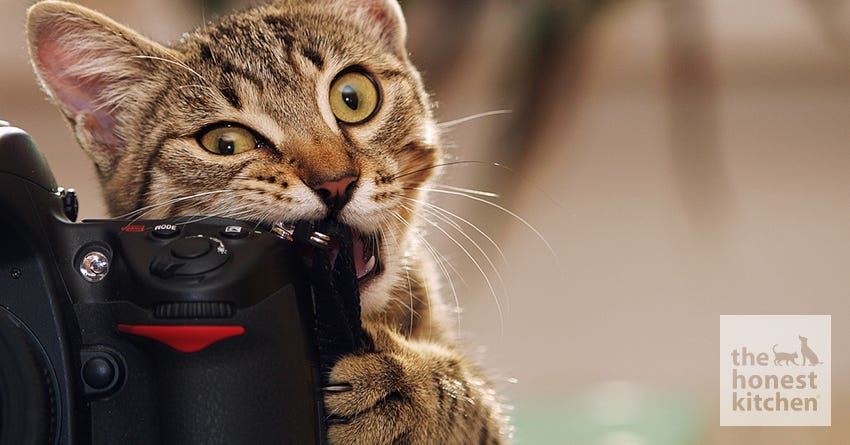Have you ever caught your cat munching on houseplants or gobbling up thread from the couch? This craving for non-food items is a disorder known as pica, and although it may seem like a silly, harmless habit, it can cause harm to your pet if it isn’t examined.
This guide will explain the signs of pica, reasons your cat may have a taste for non-food items, and strategies to prevent and treat pica.
What Is Feline Pica and What Can Cause It?
Feline pica refers to when cats eat non-edible items or things with no nutritional value, like plastics, fabrics, rubber, plants, soil, or paper. It’s common in cats of all ages, but tends to appear in younger cats. In some cases, kittens or young cats start by sucking on different materials and ingesting them in the process, or they progress to chewing and swallowing them.
Pica can become a danger to your cat’s health because it can cause blockages in their intestinal tract. The disorder isn’t well understood yet, but it could be related to a number of issues, including stress and medical issues like pancreatitis and constipation. Below, we’ll touch on some common causes of pica in cats.
Environmental Causes: Stress, Boredom, or Loneliness
Boredom, loneliness, and stress in your cat's life are common culprits with pica. A lack of environmental stimulation, like enough playtime or social time, can cause cats to turn to this compulsive disorder to have fun, relieve some stress, or get your attention.
Nutritional Deficiencies
Nutritional deficiencies, especially vitamin or mineral deficiencies, can also be one of the causes of pica. They can stem from many sources, like changing life stages, a health condition, or a poor, imbalanced diet. Some cats will naturally turn to other items as potential food sources to try to fill this nutritional void and the cravings it creates.
Medical Disorders
Several medical issues are linked to pica. These include:
- Feline immunodeficiency virus (FIV): This common disorder attacks and weakens a cat's immune system and can give them the urge to eat inedible objects.
- Feline leukemia (FeLV): The second most common cause of death in cats, FeLV attacks the immune system and pica can be a symptom.
- Dental disease: Dental disease can lead to chewing behaviors and cats eventually start ingesting the items they chew.
- Anemia: Anemia may stem from a lack of vitamins or iron, or arise from other causes, but it’s another cause of feline pica.
- Hyperthyroidism: When the thyroid is not functioning properly, your cat may feel hungry, and that can lead to eating non-food items.
- Diabetes: Diabetic cats may crave non-food items when they’re suffering blood sugar disruptions.
- Brain tumors: Brain tumors often affect a cat’s behavior because of their impact on the nervous system, which can lead to pica.
Genetics
Unfortunately, some cat breeds are more susceptible to pica than others. These breeds include:
- Siamese cats
- Burmese cats
- Tonkinese cats
- Oriental breeds
In addition, Oriental breeds are prone to sucking on wool products like bedding and consuming wool fabric in the process.
Age
Pica is very common in young cats, and it can show up as early as three months, right around the time the cat moves into a new home. Many cats outgrow the disorder by about two years.
In one study showed how pica becomes less likely as cats mature:
- For cats who were 6 months old: 42.9% of owners reported pica
- For cats who were 12 months old: 32.0% of owners reported pica
- For cats who were 18 months old: 30.9% of owners reported pica
One potential reason that young cats start eating non-food materials is that they were weaned too early. If the kittens leave their mothers before 12 weeks, they may develop a habit of sucking on things, then chewing, and finally eating.
Pica can also occur in older cats. The late onset of the problem usually has a medical cause, like an underlying health disorder or stressful situation.
Pica Signs and Symptoms
How can you spot pica, so you can adjust your cat's diet and lifestyle to combat the disorder? Here are some ideas:
Your Cat Is Eating Non-Food Items
Seeing your cat eating non-food items is a clear sign that pica is present, especially if the behavior is consistent. Some items they may consume according to International Cat Care include:
- Houseplants
- Cat toys
- Plastic
- Paper
- Cardboard
- Cat litter
- String
- Rubber bands
- Wool
- Fabrics
- Electrical cords
- Shoelaces
Don't assume that chewing is always pica. Cats may chew on things, but this doesn’t necessarily mean they’re eating them, so keep an eye on them.
Vomiting
If your cat starts vomiting and you notice non-food items in the vomit, you may have a case of pica. You can also have a cat that vomits due to an intestinal blockage caused by pica.
Lack of Appetite
Cats who have an intestinal blockage or who fill their bellies with non-food items may not want to eat their food. A sudden lack of appetite in an otherwise normal and healthy cat is a sign there may be a problem.
Behavior Change
Cat behavior problems are often one of the first clues owners get about underlying health issues. If your cat isn’t acting like their usual self, they may have a behavioral condition that is causing pica.
5 Simple Tips for Treating Pica in Cats
If you notice pica in your cat, know that the behavior can be tricky to treat, but there are measures you can take to help your cat start eating healthy food, and only healthy good, again.
1) Start By Seeing Your Veterinarian
If you suspect your cat has a medical problem or unhealthy habit, always start by consulting your veterinarian. They’ll be able to look for any underlying problems or conditions.
2) Provide Your Cat With Environmental Enrichment
If you suspect boredom is the problem, add mental stimulation to your cat's day. Doing so will keep them engaged and eliminate the desire to chew and eat items the cat shouldn't be eating.
Enrichment Activities That Help With Pica
Here are some ideas you can use to help keep your cat engaged at home:
- Give your cat some fun or restful outdoor time with a catio
- Hide treats around the house so your cat has to “hunt” for them
- Pick safe chew toys your cat can bite and nibble on
- Use cat grass or catnip as a replacement for non-food items
3) Pick Up Any Objects Your Cat Shouldn't Be Eating (But Is)
Once you notice pica behaviors, take some time to make your home safer for your cat. Be diligent to pick up the items that might tempt your cat to chew. You could also consider spraying them with a feline-safe deterrent.
4) Play With Your Cat
Cats need (and want) socialization with their owners and sometimes other animals. So, schedule regular playtime with your cat. Use an engaging toy with a mouse or feather on a string or a laser pointed to amp your cat up, raise their energy levels, and reduce stress. You can even stuff their toys with low-calorie cat treats (or hide them around the house) to help keep their interest.
5) Consult an Animal Behaviorist
If all of these tips don't work, consider working with an animal behaviorist. This professional can help you determine why your cat is struggling with pica and provide helpful advice to curb that behavior.
Feed Your Cat Things They Should Eat, Like Food From The Honest Kitchen!
Since nutritional deficiencies are a potential cause of pica in cats, make sure you’re choosing a healthy food option. The Honest Kitchen has human grade cat foods with a taste your pet will love. Each meal, treat, and supplement is full of the nutrients your cat needs for a well-rounded diet.Health Disclaimer: This post is educational in nature and doesn’t constitute health advice. Please consult your pet’s veterinarian or other healthcare professionals for specific guidance on this topic.


